I . Survey
(i) Geographical Location
Located in the south of China, Guangxi sits at 20°54′-26°23′north latitude and 104°29′-112° 04′east longitude. It borders the Beibu Gulf on the south and faces Hainan Province across the sea. To its east situated Guangdong, to the northeast lies Hunan. Guizhou is to the northwestt and Yunnan to the west. It borders with Viet Nam to the southwest. The total land area of Guangxi is 236,700 km2, accounting for 2.5% of the national total and ranking the 9th in China. Guangxi administrates 14 prefectures including Nanning, Guilin, Liuzhou, Beihai, etc. Its capital city is Nanning.
Guangxi is a coastal area. The sea area of the Beibu Gulf is about 129,300 km2, with the coastline extending 1,595 km long. 697 islands are distributed along the coast, with a total area of 84km2. Weizhou Island, as the largest island along the coast of Guangxi, covers an area of about 28km2.
(ii) Geographical Strength
Guangxi enjoys favorable geographical strength with direct accesses to sea, river and an international border. Standing at the convergence point of east China, central China and west China of the mainland and the conjunction part of South China Economic Ring, Southwest China Economic Ring and ASEAN Economic Ring, Guangxi serves as the most convenient gateway to the sea and an important passage linking Guangdong, Hong Kong and Macao SARs with west China. With the advance of China-ASEAN Free Trade Area, Guangxi will play a more important strategic role as a communicating hub connecting southwest China, south China, central China and ASEAN markets.
(iii) Climate
The climate in Guangxi is subtropical monsoon climate. Summer is long, hot and rainy, while winter is short, warm and dry. The annual average temperature is 21.1℃. July is the hottest month with monthly average temperature of 23-29℃ , and January is the coldest with average temperature of 6-14℃. The annual sunshine duration is 1,396 hours, and annual accumulated temperature of those at and above 10℃ reaches 5,000-8,300 ℃ for 270-340 days of a year. Guangxi witnesses an annual average rainfall of 1,835mm. Fangcheng in south Guangxi, Jinxiu-Zhaoping in central Guangxi, Guilin in northeast Guangxi and Rong’an in northwest Guangxi see most of rainfall with the average of above1,900mm per year. Whereas Zuojiang Valley and Youjiang Vallley in west Guangxi and basin area in central Guangxi are dry areas whose annual average rainfall is only 1,100-1,200 mm.
(iv) Population and Ethnic Groups
By the end of 2005, the total population of Guangxi had reached 49.25 million. Population density is about 208 per square kilometer. Among the total population, 16.56million are urban residents and 32.69 million are farmers.
As one of the . ve autonomous regions in China, 12 major ethnic groups, namely, Zhuang, Han, Yao, Miao, Dong, Mulao, Maonan, Hui, Jing, Yi, Shui and Gelao have being living here for generations. Another 25 ethnic minorities also live here. The population of Zhuang is 16.05 million, taking up 84.5% of the total minority population in Guangxi.
(v) Infrastructure and Transportation
Harbor
Three major coastal harbors, namely, Fangchenggang, Beihai and Qinzhou are distributed in Guangxi with a total of 75 berths, among which, 22 are deep-water berths each with a handling capacity of above 10,000 tons. The total berth capacity reaches 31 million tons. All the harbors are well connected with expressways and railways and enjoy rather complete harbor transportation service systems. As one of the 19 coastal hub harbors, Fangchenggang Harbor has 9 berths, each with a capacity of 10,000 tons. Its maximum berth capacity is 30,000 tons.
Road
The total mileage of roads reaches 62,003 km, among which, more than 1,400 km is expressway. At present, the mileage of high grade road is increasing. In addition, second grade or above roads have been accessible to all prefectures within Guangxi. The distance between major cities in Guangxi to Nanning, the capital city, is within 3-4 hours’ drive.
Railway
The railway within Guangxi has extended to 3,236.4 km and has been connected to the three major coastal harbors as well as neighboring provinces including Guangdong, Hunan, Guizhou and Yunnan, and even leading to ASEAN via Viet Nam railway network.
Airport
Guangxi has witnessed the completion of 5 civil airports respectively in Nanning, Guilin, Wuzhou, iuzhou and Beihai, with 142 domestic and international air routes. In 2005, 31 lines were openedrespectively to Hong Kong, Macao, Hanoi of Viet Nam, Fukuoka and Nagoya of Japan, Seoul of Korea, Bangkok of Thailand, Kuala Lumpur of Malaysia, Laoag of the Philippines, Phnom Penh of Cambodia, Yangon of Myanmar and Vientiane of Laos, etc.
Inland Waterway
The mileage of inland waterways in Guangxi reached 5,591 km. Xijiang waterway, with a capacity of 1,000 tons has been successfully completed. It connects Nanning with Guangzhou across the Pearl River Delta Economic Center. This waterway enjoys favorable transportation conditions.
Port
Guangxi has 17 national first-class ports. Of them, 9 are harbors (Fangchenggang , Beihai, Qinzhou, Jiangshan, Qisha, Shitoubu, Wuzhou and Guigang), 5 are inland ports (Dongxing, Friendship Pass, Shuikou, Longbang and Pingxiang) and 3 are airports (Nanning, Guilin and Beihai).
Communication (Post and Telecommunications)
Guangxi has been equipped with complete modern communication network covering the whole region.By 2005, there had been 9.312 million fixed-line users, 10.21 million mobile phone users and 1.84 million internet users.
(vi) Foreign Exchanges
Since the adoption of reform and opening up policy more than two decades ago, Guangxi has twinned with 8 foreign provinces/states as sisters. In the order of signing date, they are:
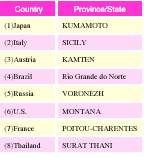
In addition, seven cities, namely, Nanning, Liuzhou, Guilin ,Wuzhou, Beihai, Hezhou and Laibin have established sister relationships with 24 foreign cites.
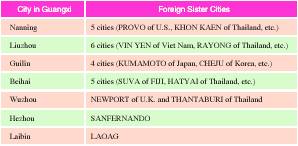
Exhibition and Event: China-ASEAN
Expo
Starting from 2004, the annually held China-ASEAN Expo (CAEXPO) in Nanning, capital city of Guangxi in every November, was proposed by Premier Wen Jiabao at the 7th China-ASEAN Summit on October 8, 2003. The CAEXPO is cosponsored by the Ministry of Commerce of the People’s Republic of China and competent business authorities of ASEAN countries and organized by the People’s Government of Guangxi Zhuang Autonomous Region.
Aiming at promoting the establishment of China-ASEAN Free Trade Area and sharing opportunities for cooperation and development, the CAEXPO has the following features: (1) CAEXPO and China- ASEAN Business and Investment Summit (CABIS), held co-incidentally, provides both real business benefits and exchanges and dialogue among government officials, entrepreneurs, scholars and experts. (2) It is not only a grand event for economy and trade, but also a multilateral activity. It will be of great signi. cance to the establishment of China-ASEAN strategic partnership for peace and prosperity and push forward regional economic cooperation between China and ASEAN countries. (3) It is a combination of import and export with import as the mainstay. The opening of ASEAN markets will serve as a bridge for ASEAN commodities to enter China. (4) It is a combination of outbound investment and foreign investment attraction. It will serve as a platform for Chinese enterprises to invest in ASEAN and go global. (5)It is a combination of trade in goods and trade in services. Starting from tourism services and transfer of innovative technology in SMEs, the CAEXPO will foster a new growth point for China-ASEAN business cooperation. (6) A combination of business activities and cultural exchanges. During the EXPO, Nanning International Folk Song Festival, A Gala Celebration, Fashion Show Week and Golf Tournament will also help boost the cultural exchanges between China and ASEAN.
The 1st CAEXPO saw a total commodity transaction volume of US$1.084billion, contractual amount of international project of US$4.97 billion, contractual amount of domestic project of US$48.5 billion. Commodity transaction of the 2nd CAEXPO reached US$1.15 billion, contractual amount of international project of US$5.26 billion, contractual amount of domestic project of US$50.2billion. After the success of the first two sessions, CAEXPO has become the nearest channel for more ASEAN commodities to enter China, the best platform for ASEAN enterprises to purchase Chinese products, the optimum bridge for ASEAN to attract investment and advanced applicable technologies from China, an important venue for ASEAN to showcase their tourism attractions for more Chinese tourists and an effective international business event. China-ASEAN Expo has become one of the four major events supported by the Ministry of Commerce of China. This year, held concurrently with the Commemorative Summit Marking the 15th Anniversary of ASEAN-China Dialogue Relations, the third
session will surely be more successful and exert much greater impact.
(vii) Higher Education and Science & Technology
Higher Education
Up to the end of 2005, Guangxi had established 58 universities and colleges, 234 authorized master degree programs and 12 doctoral degree programs. The number of college and university students reached 483,600, among which10,711 are postgraduates.
Science & Technology
By the end of 2005, Guangxi had set up 210 scienti. c research institutions above county level, among which, 7 were at the national level, 68 at the provincial level and 58 at the county level. By the end of 2005, Guangxi witnessed a registration of 7,038 scientific and technological results, and 2,868 of them won prizes: 1 national first prize, 6 national second prize, 10 national third prize; 3 special contribution award of Guangxi for scientific and technological progress, 48 first prize, 572 second prize and 2,245 third prize at the provincial level. Many of these results have been applied to practice and have made important contribution to Guangxi’s national economic development. Research on buffalo IVF (invitro fertilization) embryo transfer and fish nucleolus transfer and breeding are of the international leading position. Hybrid rice varieties such and Shan you Gui series, Boyou series and Shanyou 30 are of high yield, high quality and strong adaptability. A combination of early, medium and late ripe varieties has been developed; Guitang 11 sugar variety has been bred which has been applied widely in China.
Patent and IPR
By August, 2006, Guangxi had made 27,834 applications for patents and 15,303 were granted.
(viii) Tourism and Local Products
Tourism
Guangxi is one of the major tourism provinces of China. More than 400 scenic areas and spots have been developed, among which, 3 are national scenic areas, 1 holiday resort and 11 forest parks; other 31 areas and 9 holiday resorts are at the provincial level. The landscapes in Guilin represent the unique natural sceneries featuring with karst land formation which is prevalent across Guangxi; Beihai Silver Beach shows the beautiful sub-tropical coastal scenes; minority ethnic customs and folk cultures are fully demonstrated here by different minorities; Huashan Pictographs, Ling Cannal, Pavillion of Genuine Prowess, Site of the Taiping Heavenly Kingdom Uprising are precious historical relics. Unique border sceneries, attractive landscapes and diversified folk cultures make Guangxi an ideal destination for tourists at home and abroad. In 2005, Guangxi received 1.462 million tourists from outside of the mainland China and the tourism revenue reached 2.59364 billion yuan.
Local Products
As one of the major agricultural provinces in China, Guangxi is rich in farm produce, represented by tropical and subtropical fruits such as Lichee, Longan, pineapple, mango, banana, cumquat, Shatian pomelo, TCM crops including tianqi (pseudo-ginseng), amomum fruit, gynostemma pentaphyllum, luo han guo(Fructus Siraitiae Grosvenorii), aquatic products like prawn, tilapia, pearl and oyster and agricultural by-products including vegetables, sugarcane, . ber crops, silkworm, turpentine, tung oil, cassava, aniseed, anise oil, cinnamon, etc. Sugar-making and can tin are flagship industries in agricultural products processing. The output of sugar accounts for more than a half of the national total. Pineapple, green bean, water chestnut tin packets are selling well home and abroad. There are also traditional handcrafts and artistic works such as fireworks, Zhuang embroidery, Yao embroidery, shell carving, knitting, etc.
II . Economy
(i) Economic Development of Guangxi
In recent years, Guangxi’s economy has maintained a rapid, steady and balanced development momentum. In 2005, GDP exceeded 400 billion yuan , 407.575 billion yuan to be exact, up by 13.2%. The total production value of primary industry reached 91.25 billion yuan, and its contribution rate to economic growth was 11.8%. The total value of secondary industry was 151.068 billion yuan, and contributed 56.2% to economic growth and the increment of tertiary industry amounted to 165.257 billion yuan, and contributed 32% to economic growth. Per capita GDP (taking into account the permanent residents) was 8,788yuan. Per capita GDP exceeded US$1,000. In 2005, the fiscal revenue of Guangxi exceeded 40 billion yuan, 47.537 billion yuan to be exact.
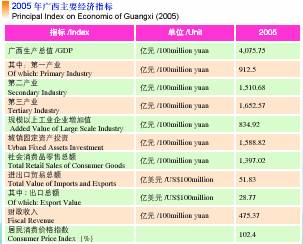
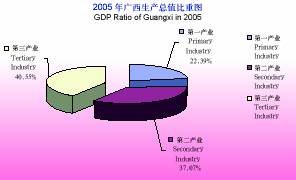
(ii)Resources of Guangxi
Water Resources
Guangxi enjoys rich water resources with plenty of rainfall and many rivers. The total length of surface rivers is 34,000km with a water area of about 4,700km2. Each of the 937 rivers has accumulative rain area of more than 50km2. 246 rivers have a theoretical deposit of above 10,000 kilowatts each, and the developable capacity is 18.97 million kilowatts. The annual power generation capacity is 81.1 billion kwh, ranking 8th in China and is one of the three major priority bases to develop hydropower resources. The total installed capacity of Longtan Hydropower Station, which is now under construction and is a special large hydropower project, will be 5.4 million kw. only second to the Three Gorges Project. Will be 5.4 million kw.After completed, besides power generation and . ood prevention, it will share some pressure with downstream cascade hydropower stations.
Mineral Resources
Guangxi is one of the ten key nonferrous metals production areas in China. 145 mineral have been discovered (including subminerals), among which, the reserves of 97 minerals have been proved and 64 rank Top 10 in China in terms of deposits. And among the top 64, 14 rank national first including manganese, indium, hafnium, scandium, arsenic, bentonite, limestone for fertilizer, piezo-electric quartz, agate, shale for bricks or tiles, shale for cement matching materials, clay for bricks and tiles. Manganese and tin reserves account for 1/3 of the national total respectively; 25 of the 64 minerals are ranking 2nd to 6th of the national total (the deposit of antimony accounts for 1/4 of the national ensured reserve). Pingguo Aluminum Base, Dachang Tin-Polymetallic Ore Field and Laibin Manganese Ore Field are all famous ore fields in China and enjoy great potential for development.
Forest Resources
The warm and humid climate i n Guangxi provides favorable environment for plants and animals. Guangxi has more than 280 families of plants with nearly 8,000 species. The forest area of Guangxi is 9.8191 million hectares, with a coverage rate of 41.33%. There are more than precious 30 species of trees including silver . r, ‘nanmu’ (Chinese juniper wood), teak and tiemu (Mesua ferrea Linn). 729 species (or subspecies) of amphibian animals and 40 of them are included in the national protection list. More than 700 species of fruits, particularly tropicalfruits, such as pineapple, lichee and mango.
Marine Resources
The beach area along the coast of Guangxi is 1,005 km2, and 6,488 km2 are shallow waters within the depth of 20 meters. As a famous Chinese . shery ground, Beibu Gulf has 500-odd . sh species and over 220 shrimp or crab species. In the shallow sea area, there are more than 50 economic fish species and 10-odd commercial shrimp species. Hepu Pearls are abundant here. With rich marine mineral resources, the coastal areas enjoy large deposits of titanium, quartz sands and xenotime. There are also some reserves of petroleum and natural gas in the shallow sea area in southwest Beihai.
(iii) Industrial Development of Guangxi
In 2005, industries in Guangxi witnessed fast development. The industrial increment of large scale industries hit 126.484 billion yuan. The contribution rate of industries to economic growth reached 47.6%. The development of heavy industries picked up speed with an increment of 54.25 billion yuan, and the increment of light industries amounted to 29.242 billion yuan. The contribution rate of metallurgy, power, automobile, nonmetallic products, chemical industry and agricultural by-products to industrial growth reached 70%. Enterprises with different ownerships developed together, among which, the increment of SOEs hit 21.493 billion yuan; and that of the collective ownership increased 1.83 billion yuan; shareholding companies, 31.997 billion yuan, and enterprises with foreign or Hong Kong, Macao and Taiwan investments, 15.815 billion, yuan.
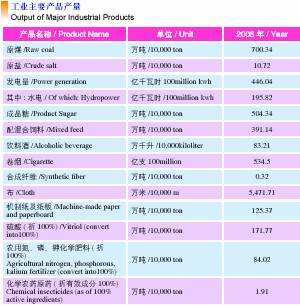
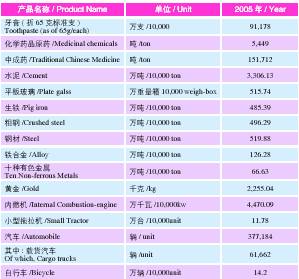
(iv) Agricultural Development of Guangxi
Guangxi is a major agricultural province and is abundant in agricultural products including south sub-tropical fruits, vegetables, sugarcane, hemp crops, silkworm, medicinal crops, perfume crops, turpentine, tung oil, three yellow chicken, milk buffalo and aquatic products. In 2005, the gross output value of agriculture, forestry, stock raising and fishery was 144.837 billion yuan, among which, 71.189billion yuan for agriculture, 6.168 billion yuan for forestry, 51.16 billion yuan for stock raising and 14.361 billion yuan for fishery.
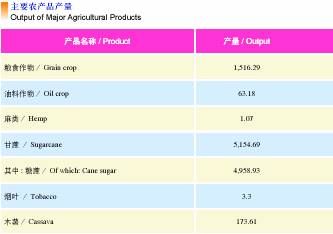
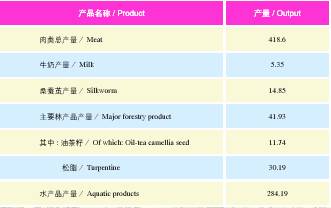
(v) Commercial Development of Guangxi
Import and Export
In 2005, the total import and export value was US$5.18285 billion, among which, US$2.30544 billion yuan for import and US$2.87741 billion for export. In the same year, 173 countries and regions did business with Guangxi and the export to the 5 major traditional markets, namely, ASEAN, EU, US, Hong Kong and Japan, reached US$2.18442 billion, taking up 75.9% of Guangxi’s total export. ASEAN remained as Guangxi’s largest trading partner, enjoying an import value of US$830.59 million from Guangxi. The TOP 10 countries or regions in terms of import value from Guangxi were Brazil, Vietnam, Australia, the U.S., Japan, Indian, Germany, Korea, Taiwan of China and Canada.
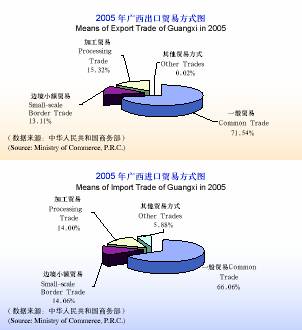

Foreign Investment Utilization
In 2005, Guangxi saw the establishment of another 351 foreign invested enterprises. Of them, 25 were large projects with additional contractual foreign capital of US$10 million, a contractual value of 1.10182 billion. The actually utilized FDI was US$378.66 million.
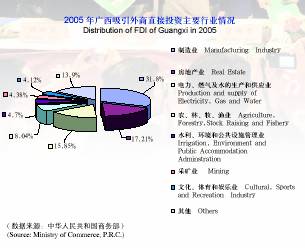
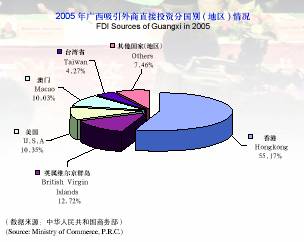
Foreign Economic Cooperation
In 2005, the contracted volume of foreign contracted projects and labor cooperation amounted to US$ 399.98 million. The turnover was US$ 25.03 million. The volume of FDI to foreign countries amounted to US$ 14.9695 million, among which, Chinese investment was US$11.8895 million, covering 12 countries and regions, including Vietnam, Hong Kong, Malaysia and Angora, etc.
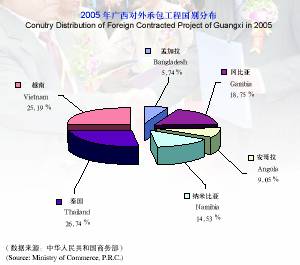
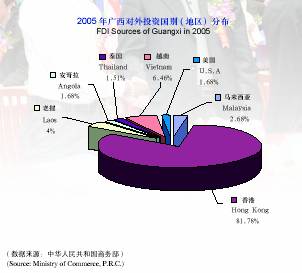
Domestic Trade
In 2005, the total retail sales of consumer goods in Guangxi hit 139.7 billion yuan.Various wholesale and retail markets witnessed great improvement. Chain businesses, logistics and distribution, e-commerce and other modern circulation means developed fast. Guangxi Government attached great importance to the recti. Cation of market economy order and have helped the enterprises to create new brands and protect the intellectual property rights. With the acceleration of opening up of business sectors, many well-known domestic circulation enterprises and famous transnational groups have come to Guangxi to do business.
(vi) Industrial Infrastructure
Sugar Making
Sugar making industry of Guangxi occupies an important position in China. The cane sugar output accounts for more than a half of the national total. With a long industrial chain of sugar making industry, its comprehensive utilization technologies including making paper or board from bagasse, produce amino acid, single-cell protein, alcohol and extraction of acetone and other organism chemicals, compound fertilizer from filter mud, have reached the top level in the world.
Power Industry
In 2005, the power generation capacity was 44.604 billion kwh. By 2010, the total installed capacity of Guangx will reach 25.6 million kw; by 2020, it will hit 50 million kw and gradually Guangxi will become an important base for the national project of “transmitting electricity from the west to the east”.
Machinery Industry
A group of competitive enterprises have taken shape, covering 11 sub-trades of Guangxi’s machinery industry, such as, Yuchai Machinery, Co., Ltd, the largest internal combustion engine producer nationwide; Liuzhou Construction Machinery Factory, the national No.1 producer of prestress works, and Liuzhou Engineering Mchinery Co., Ltd, a flagship enterprise in loading machinery industry of China.
Automobile Industry
Automotive industry is one of the pillar industries, and Guangxi is making every effort to develop it. In 2005, the output of automobiles was 380,000 units. Three major domestic automobile groups including China First Automotive Works, Shanghai Automotive Industry Corporation(Group) and DongFeng Auto Factory as well as international auto companies such as GM of the U.S. and Renault of Korea have built up production bases in Guangxi. An auto parts industrial chain centering with Liuzhou, Yulin, Nanning and Guilin is gradually taking shape. Auto parts manufacturing is also further improved.
Aluminum Industry
Aluminum industry is a competitive pillar industry in Guangxi with the largest potential for development. By the year of 2010, Guangxi will have an annual capacity of 5 million tons of alumina, 1.5 million tons of electrolytic aluminum and 1.2 million tons of aluminum processing and become an important aluminum industrial base in Asia, even the world at large.
Pharmacy
With rich TCM resources, Guangxi has produced 13 medicaments TCM products with 410 varieties, among which, 18 of them are new varieties in China and 55 are in the national TCM protection list. A group of excellent brands have formed including Watermelon Frost and Golden Throat Lozenge. At present, GMP reconstruction of pharmacy enterprises in Guangxi has been initially completed and now Guangxi is going on the way for research on plantation of TCM GAP (standard for TCM quality control) and industrialized plantation.
Food Industry
Various tropical and sub-tropical fruits, vegetables, sea products and local economic crops provide abundant raw materials for food industry. So far, a group of well-known brands such as Halves Foodstuff, Wuzhou Bingquan Food, Liuzhou Golden Throat and Xiangshan Can Food have been established. The output of can food ranks national third.
(vii)Brand Commodities
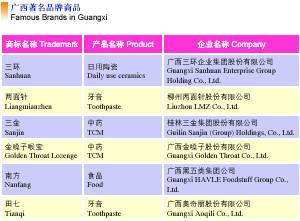
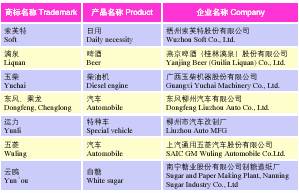
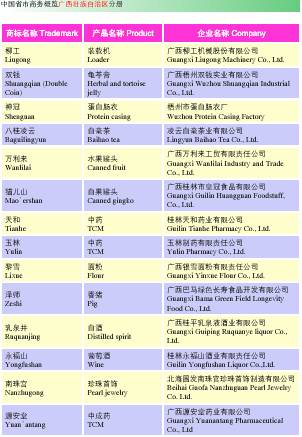
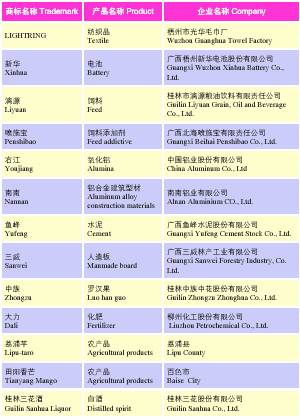
III . Investment
(i)Policy and AdministrativeRules
Catalogue of Related Laws
Foreign Trade Law of the People’s Republic of China
Customs Law of the People’s Republic of China
Law of the People’s Republic of China on Import and Export Commodity Inspection
Law of the People’s Republic of China on Chinese-Foreign Equity Joint Ventures
Law of the People’s Republic of China on Chinese-Foreign Contractual Joint Ventures
Law of the People’s Republic of China on Foreign-Capital Enterprises
Company Law of the People’s Republic of China
Law of the People’s Republic of China on the Entry and Exit Animal and Plant Quarantine
Law of the People’s Republic of China on Control of the Entry and Exit of Aliens
Law of the People’s Republic of China on the Control of the Exit and Entry of Citizens
Securities Law of the People’s Republic of China
Income Tax Law of the People’s Republic of China for Enterprises with Foreign Investment and Foreign Enterprises
Individual Income Tax Law of the People’s Republic of China
Law of the People’s Republic of China on the Administration of Tax Collection Environmental Protection Law of the People’s Republic of China
Law of the People’s Republic of China on Evaluation of Environmental Effects
Law of the People’s Republic of China on Promotion of Cleaner Production
Law of the People’s Republic of China on Prevention and Control of Desertification
Marine Environment Protection Law of the People’s Republic of China
Law of the People’s Republic of China on the Prevention and Control of Atmospheric Pollution
Law of the People’s Republic of China on Prevention and Control of Environmental Pollution by Solid Waste
Law of the People’s Republic of China on Prevention and Control of Water Pollution
Law of the People’s Republic of China on Prevention and Control of Environmental Noise Pollution
Law of the People’s Republic of China on Prevention and Control of Radioactive Pollution
Frontier Health and Quarantine Law of the People’s Republic of China
Labour Law of the People’s Republic of China
Trade Union Law of the People’s Republic of China
Searching Website for the Related
Laws
1. Searching System of Laws and Regulations of China (website of National People’s Congress of China)
http://law.npc.gov.cn:87/home/begin1. cbs
2. China Legislative Information Network System
http://www.chinalaw.gov.cn/jsp/jalor/index.jsp
3. Ministry of Commerce
http://www.mofcom.gov.cn
the above-mentioned websites are for reference only.
(ii) Industrial Policies
Catalogue for Guidance of Foreign-invested Industries and Catalogue of Competitive Industries for Foreign Investment of Guangxi are policy basis of examination and approval that are applicable to foreign-invested projects. Projects listed in the Catalogue of Competitive Industries for Foreign Investment of Guangxi are regarded as the encouraged projects for foreign investment.
● Catalogue for Guidance of Foreign Invested Industries
For details , please refer to website of the Department of Commerce of Guangxi (http://guangxi.mofcom.gov.cn)column of Guangxi Survey.
● Encouraged Competitive Industries for Foreign Investment in Guangxi
1. Integrated development and utilization of cassava
2. Planting and processing of natural spices
3. Post-Industry development of state key bio-engineering such as reforesting some of the cultivated land
4. Technological development and application of water-saving irrigation
5. Sugar re. nery and complex utilization of its byproducts
6. Development and manufacture of animals and botanical resources (excluding Stateprotected species)
7. Indium, lead and zinc re. nery and application
8. Manganese re. nery
9. Mining, separation and processing of talcum and barite
10. Rosin re. nery
11. Manufacture of . uoride salt
12. Construction and management of gas, keating, and water and drainage pipe networks (controlled by Chinese parties in medium and big cities)
13. Development of tourist resorts (scenic spots), construction, protection and management of supporting facilities
14. Highway passenger transportation
(iii) Procedures for Investment and Authorities for Examination and Approval
1. Requirements, Procedures for Establishment and Authorities for Examination and Approval of Foreign-invested Enterprises
(1) Requirements
Conforming to “Catalogue for Guidance of Foreign-invested Industries” and “Catalogue of Competitive Industries in the Central and West China”.
(2) Procedures for establishment of foreign-invested enterprises
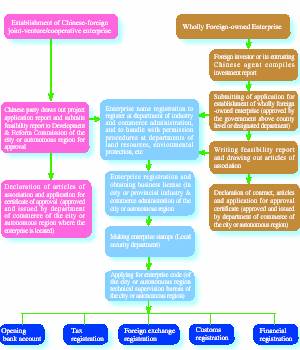
(3) Authorities for examination and approval of foreign-invested project
● Authorities of state competent department for examination and approval
Foreign-invested projects in the encouraged category and allowed category with total investment of USD 100 million or over.
Foreign-invested projects in the restricted category with total investment of USD 50 million or over
● Authorities of autonomous region for examination and approval
Foreign-invested projects in the encouraged category and allowed category with total investment less than USD 100 million
Foreign-invested projects in the restricted category with total investment less than USD 50 million or over
● Authorities of municipality under the autonomous region for examination and approval
Foreign-invested projects in the encouraged category and allowed category with total investment less than USD 30 million, requiring no overall balance of Guangxi
● Authorities of counties (cities), urban districts and suburbs in municipality under the autonomous region for examination and approval
Cangwu County, Hepu County, Fangcheng District of Fangchenggang City, Pingxiang City and Dongxing City are authorized to examine and approve foreigninvested projects in the encouraged and allowed categories with total investment less than USD 20 million.
Counties (cities), urban districts and suburbs in municipality under the autonomous region are authorized to examine and approve foreign-invested projects in the encouraged and allowed categories with total investment less than USD 5 million.
2. Procedures for Establishment and Authorities for Examination and Approval of Chinese-invested Projects
In accordance with the Central Government and Guangxi’s policies for Western Development and related laws and provisions, Guangxi further simplifies the procedures and transfers authorities for examination and approval of domestic investment to lower levels. Registration and filing system are adopted in projects that require no examination and approval.
(iv)Reference Prices of Basic Elements
1. Water Reference Price
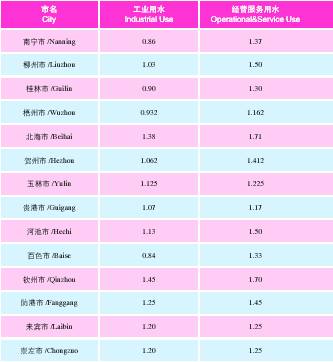
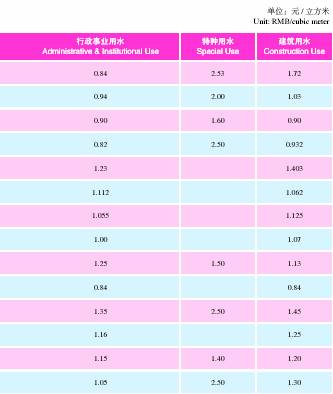
2. Power Reference Price
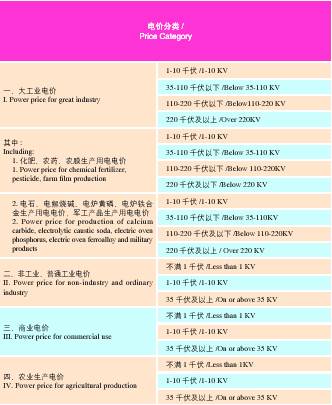
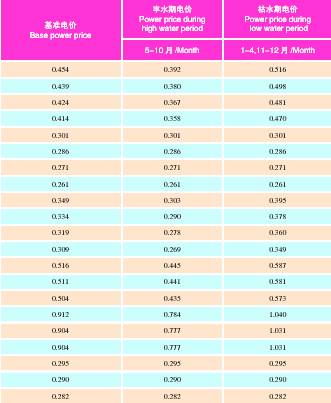
3. Labor Cost
Ordinary worker:400-700 RMB/month
Ordinary managerial staff:500-1,000RMB/month
Senior managerial staff: 900 RMB/month
(Monthly salary to be adjusted in accordance with the Provincial Minimum Salary Standard for Employees in Guangxi)
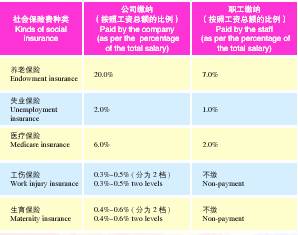
IV. Development Zones
By the end of 2005, there were 41 economic development zones in Guangxi, among which are 7 state-level development zones: Nanning Economic and Technical Development Zone, Guilin High-tech Industrial Development Zone, Nanning High-tech Industrial Development Zone, Guangxi Beihai Exports Processing Zone, Pingxiang Border Economic Cooperation Zone, Dongxing Border Economic Cooperation Zone and Beihai Silver Beach National Tourism Resort.
(i)State-level Development Zones

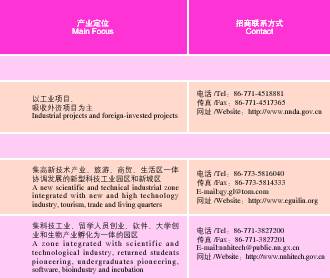
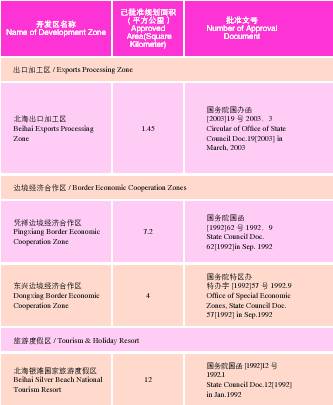

(ii) Provincial-level Economic and Technological Development Zones
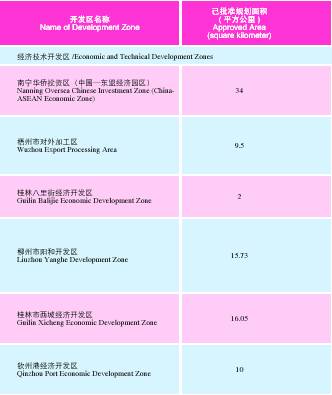
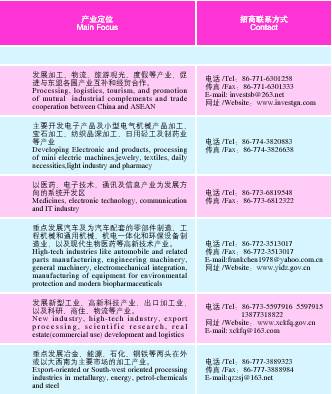
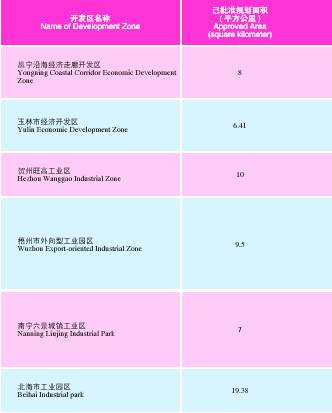
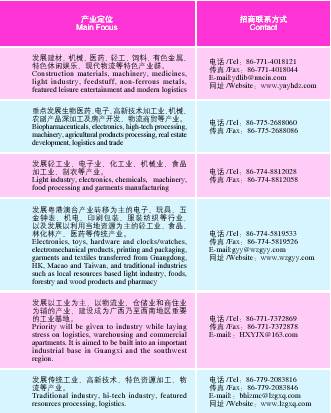
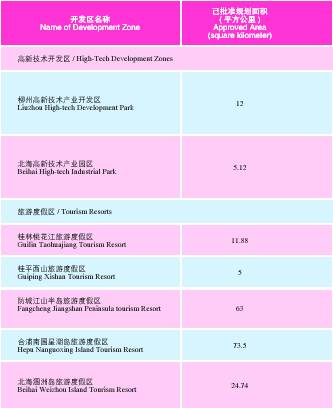
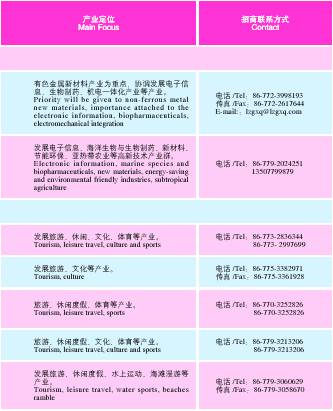
(iii) Relevant Organizations
1. Entry and Exit Administrative Institutions .


2.Commercial Institutions
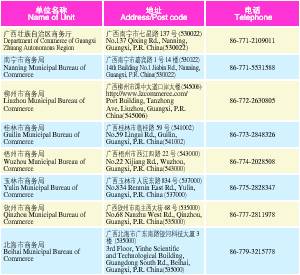
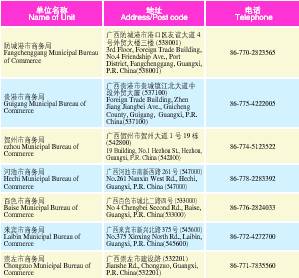
3.Financial and Foreign Exchange Institutions
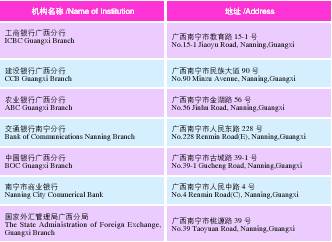
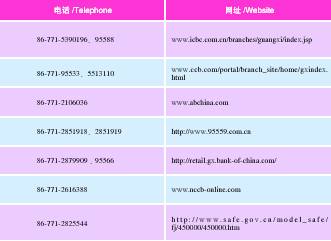
4.Organizations on Foreign Affairs
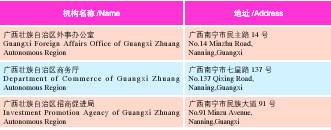
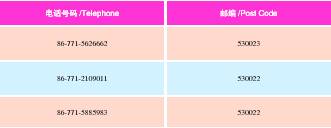
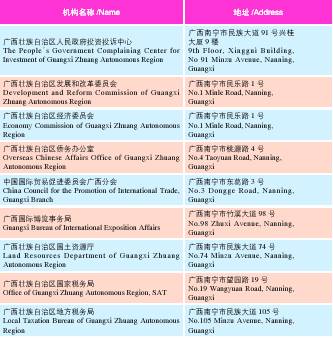
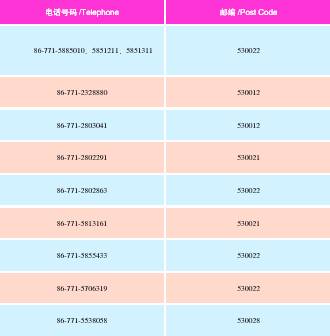
(iv) Related Websites
Ministry of Commerce of the People's Republic of China: www.mofcom.gov.cn Guilong News:www.gxnews.com.cn The People’s Government of Guangxi Zhuang Autonomous Region:www.gxzf.gov.cn
Department of Commerce of Guangxi Zhuang Autonomous Region:w w w .gxdoftec.gov.cn
Investment Promotion Agency of Guangxi Zhuang Autonomous Region:www.gxipn.gov.cn
China-ASEAN Exposition: www.caexpo.org
Appendix
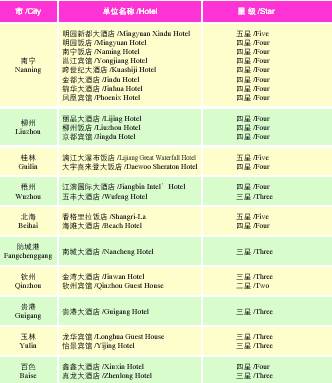
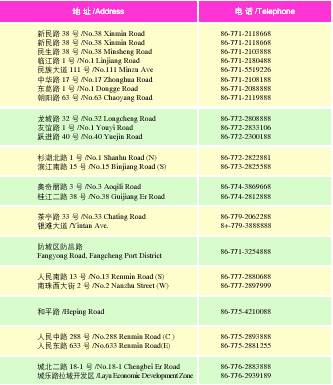
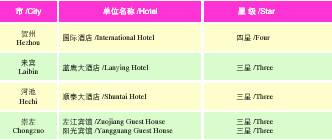
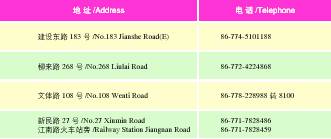
Useful Telephone Numbers
Emergency:
Police:110
Fire. ghting:119
Medical Emergency:120
Traf. c accident:122
Other Useful telephone numbers:
Weather forecast:121
Telephone Number Inquiry Service:114
Langdong Bus Terminal Inquiry:86-771-5508319
Airport Ticket Inquiry:86-771-2431459
Flight Inquiry:86-771-2825377
(Ministry of Commerce)